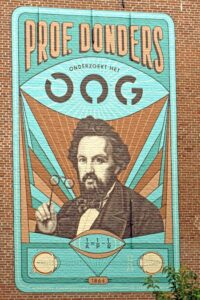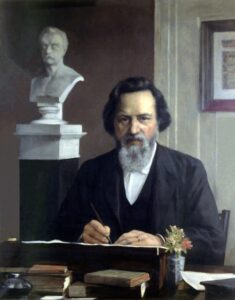Mural paintings
Professor Donders studies the eye
What does the mural show?
 This mural depicts Franciscus Cornelis Donders, the pioneer of ophthalmology in the Netherlands. He is famous for his studies of eye disorders, eye diseases and for his many ingenious ophthalmic and optical instruments.
This mural depicts Franciscus Cornelis Donders, the pioneer of ophthalmology in the Netherlands. He is famous for his studies of eye disorders, eye diseases and for his many ingenious ophthalmic and optical instruments.
Prof. Donders gave scientific explanations, often based on insights from physics, for common eye disorders such as nearsightedness and farsightedness. He is furthermore known for his clever reasoning about psychological processes in the brain by introducing for the first time a technique to estimate the ‘time it takes to think’ in reaction time tests. The same rationale is still used in contemporary brain research.
Finally, Prof. Donders founded the first Dutch hospital for eye patients (‘Hospital voor deprived and underprivileged eye sufferers’), and served as its first director. This was a famous charitable institution, where patients from all levels of society were welcome to receive free treatment for their eye problems. In the words of Prof. dr. Donders from 1870:
“… that the treatment of all sufferers, without exception, is free of charge, and that, moreover, medicines, surgical aids, and, if necessary, also optical means, artificial eyes, etc., are provided free of charge. …. Neither sign nor evidence that they belong to the poor is demanded from the sufferers. It is enough that they are suffer from an eye disorder. The foundation is therefore an exclusively charitable institution.”
From 1858 to 1895 this hospital was located at the Wijde Begijnestraat 1. The mural can be found on the side of this monumental building.
Where can the mural be found?
 Franciscus Cornelis Donders was born on May 27, 1818 in Tilburg. He studied in Utrecht, including at what is now the Central Military Hospital, and obtained his doctorate in Leiden in 1840 with a dissertation on meningitis. After serving several years as a military doctor in the army, he was appointed professor in Utrecht in 1847. His inaugural lecture was one of the first in Utrecht to be given in the Dutch language instead of the usual Latin. He taught forensic medicine, biology and ophthalmology, and later physiology. His specialization in ophthalmology made him the most important Dutch physician of his time.
Franciscus Cornelis Donders was born on May 27, 1818 in Tilburg. He studied in Utrecht, including at what is now the Central Military Hospital, and obtained his doctorate in Leiden in 1840 with a dissertation on meningitis. After serving several years as a military doctor in the army, he was appointed professor in Utrecht in 1847. His inaugural lecture was one of the first in Utrecht to be given in the Dutch language instead of the usual Latin. He taught forensic medicine, biology and ophthalmology, and later physiology. His specialization in ophthalmology made him the most important Dutch physician of his time.
The text below is largely taken (and translated) from the magazine of Oud Utrecht, 92nd volume, April 2019.
In 1851 Prof. Donders visited the world exhibition in London and the two large eye clinics in that city. There, he met the famous anatomist and eye surgeon William Bowman (1816-1892) and the eye surgeon Albrecht von Graefe (1828-1870) from Berlin. Donders, Bowman and von Graefe became lifelong friends within one month and the three of them laid the foundations of modern ophthalmology. The German physiologist Helmholtz (1821-1894) also made an important contribution to this, by inventing the ophthalmoscope in the same year. With this instrument, the retina of live patients could be examined for the first time. This revolutionary tool opened countless new possibilities for diagnosing and treating eye disorders. It was von Graefe who told Donders and Bowman about this new invention. Back in the Netherlands, Donders officially presented himself as an ophthalmologist and patients came to Utrecht from far and wide. Donders had rented a room at the Hoogt to examine the eye patients together with his students. It enabled him to significantly improve ophthalmology within two years and to publish the first color atlas of retinal disorders. The patient numbers increased so much that expansion became necessary. In 1858, Donders collected ƒ40,000 through a clever crowdfunding campaign for the establishment of a ‘Nederlandsch Gasthuis for destitute and underpowered Eye sufferers’ on the Wijde Begijnestraat. After the death of Donders, the Ooglijdersgasthuis moved to a new building on the F.C. Donders Street in 1895. The eye hospital was independent of the university. Donders became director and his closest assistant Herman Snellen (1834-1907) the resident physician. Snellen quickly proofed himselda skilled eye surgeon and thus complemented Donders well, because he – in his own words – ‘had no special vocation’ for eye surgery. Snellen is known for the Snellen chart, the well-known tool that can be used to easily determine how clearly someone can see.
As an ophthalmologist and physiologist, Donders was particularly interested in the refractive errors of the eye. He began years of systematic research and was the first to define farsightedness (inability to see close objects clearly). The refractive error astigmatism was known, but Donders was the first to make it possible to detect and treat the deviation with cylindrical lenses. The method developed by Prof. Donders to determine a recipe for correct glasses still forms the basis of the system used today.
In 1864 the results of numerous studies were compiled in a book, published in England: On the anomalies of accommodation and refraction of the eye. With a preliminary essay on physiological dioptrics. Donders dedicated it to his friend William Bowman. It meant his international breakthrough. It has been translated into many languages and is so clearly written that it is still easy to read today. Donders explains difficult subjects to ophthalmologists in simple terms in this book.
In 1862 the chair of physiology in Utrecht became vacant. In tough negotiations with the university, Donders got the university to built a new laboratory for him (otherwise he would go abroad). The for the time ultramodern Physiological Laboratory was realized at the Van Asch van Wijckskade in the period 1865-1867, and Donders become its first director. It is striking that at the same time he stayed on as director of the Ooglijdersgasthuis. Donders published his second masterpiece in the new laboratory in 1869, with which he again gained international fame: a publication about the time it takes for the brain to process a task or stimulus (mental chronometry). As such Donders can be considered as one of the fathers of the field we now know as cognitive neuroscience. Other subjects that Donders published on, were breathing, blood circulation in the brain and breastfeeding. In 1866 he was elected as a foreign member of the prestigious Royal Society of London; the famous Dutchmen Anthonie van Leeuwenhoek and Herman Boerhave preceded him in this. The result of Donders’ creative drive as an ophthalmologist and physiologist is still clearly visible in Utrecht: thanks to him, two impressive buildings are still standing 200 years after his birth: the former Ooglijdersgasthuis and the former Physiologsich Laboratory.
Although he had returned to physiology, Donders remained interested in ophthalmology. He wrote publications on color sense, eye movements and depth perception. He also investigated the sense of color in relation to the public safety of the railways: a train driver should not be color blind to be able to perceive the signals properly. Donders not only designed a color sense test for railway employees, he also researched color perception on railway yards and rode a locomotive himself to be able to perceive signals from that position. With the application of scientific color sense research in the public safety domain, Donders was once again far ahead of its time. In addition, he openly argued against child labor and for better hygiene in slums. Its success also provoked a degree of vanity that disturbed contemporaries.
Donders died on Sunday, March 24, 1889. His impressive funeral was reported in the national media. He left behind an impressive 339 scientific articles and supervised 44 PhD students.

